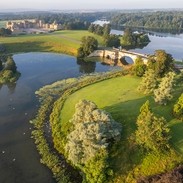
The Lake District, Cumbria
A UNESCO World Heritage Site, known for its dramatic fells with towering peaks and ever-changing light, its glittering lakes and literary legacy, the Lake District has inspired poets, adventurers and hikers for centuries. Whether visitors are here to follow in the footsteps of poet William Wordsworth, conquer the peaks or simply breathe in the crisp mountain air, there are plenty of unforgettable experiences.
Start the journey at Dove Cottage and Wordsworth Grasmere, the former home of Wordsworth, where the poet wrote some of his most famous works. A visit offers a glimpse into the Romantic era, complete with original manuscripts and cosy, candlelit rooms. From poetry to prehistoric wonders, Castlerigg Stone Circle is another gem – the mystical Neolithic ring of standing stones predates Stonehenge and offers panoramic views in the Lakes.
For those keen to embrace the wilder side of the Lakes, Wild Human delivers immersive outdoor experiences, from bushcraft and wild swimming to survival skills deep in the Cumbrian wilderness. Meanwhile, thrill-seekers can venture underground at Honister Slate Mine, where via ferrata climbs and subterranean tours highlight the region’s industrial heritage with a heart-pounding edge.
No trip to the Lakes is complete without time on the water. Glide across Lake Windermere with Windermere Lake Cruises, offering everything from relaxing sightseeing tours to steamboat journeys on England’s largest lake. Over at Ullswater, Ullswater Steamers provide another scenic voyage, sailing past peaks and valleys that have changed little since Wordsworth’s day.

Hadrian’s Wall, Northumberland
Stretching across the wild landscapes of Northern England, Hadrian’s Wall is one of Britain’s most iconic UNESCO World Heritage Sites. Built by the Romans nearly 2,000 years ago to guard the empire’s northern frontier, this monumental structure still captivates with its sheer scale and rich archaeological sites. From the windswept crags of Housesteads Roman Fort to the Corbridge Hoard exhibition, walking along Hadrian’s Wall offers an immersive journey into Britain’s ancient past.
For those keen to follow in the footsteps of Roman legionaries, the Hadrian’s Wall Path provides a scenic long-distance trek. This 84-mile National Trail runs coast to coast, offering spectacular views of the Northumberland countryside. While a full hike takes around a week, shorter sections allow for day walks past well-preserved ruins and museums showcasing Roman life on the frontier.
Looking for adventure beyond the history books? Adventure Northumberland delivers thrilling outdoor experiences in the area. Visitors can try their hand at rock climbing on the region’s imposing crags, kayak along tranquil rivers or test their aim with archery – all within reach of the ancient wall. For a unique stay, eco-friendly glamping pods in Northumberland provide a cosy retreat after a day of exploration, allowing visitors to blend the wild beauty of this historic landscape with home comforts.

Cornwall and West Devon Mining Landscape, Cornwall and Devon
Cornwall and West Devon’s mining heritage is woven into the towering cliffs, rolling moorlands, and hidden valleys of this UNESCO-listed landscape. Once the heart of the world’s tin and copper industries, the region is now a treasure trove of historic sites, coastal scenery and outdoor adventures. From the ruins of engine houses perched above the Atlantic Ocean to the stories of the miners who shaped this land, exploring the area is like stepping into a living history book.
Start the journey at St Michael’s Mount, a tidal island steeped in legend. While it may not be a direct relic of the mining era, it embodies Cornwall’s rich history and maritime connections. Walk across the causeway at low tide or hop on a boat to explore the medieval castle, subtropical gardens and take in the sea views.
For a cultural escape with a view, visit the Minack Theatre, an open-air amphitheatre carved into the cliffs above Porthcurno. Originally created by theatre visionary Rowena Cade in the 1930s, this venue hosts plays, musicals and performances from Easter until October, all set against a backdrop of crashing waves.
Experience Cornwall’s natural beauty at a more relaxed pace, cycle or walk the Camel Trail, a scenic 18-mile route along a disused railway line. Winding through woodlands, estuaries and the charming town of Padstow, this flat and accessible trail offers a different perspective of Cornwall’s landscape.

Castles and Town Walls of King Edward in Gwynedd, Snowdonia (Eryri) and v
Rising like stone giants from the Welsh landscape, the Castles and Town Walls of King Edward in Gwynedd are some of the finest medieval fortifications in Europe. Built in the late 13th century as part of Edward I’s campaign to conquer Wales, these UNESCO-listed strongholds – Caernarfon, Conwy, Harlech and Beaumaris – remain striking examples of military architecture. But beyond their towering walls and strategic battlements, this region offers modern-day adventurers plenty of ways to explore and experience the surrounding landscapes.
For a scenic journey, hop aboard the Snowdon Mountain Railway, which has been carrying visitors to the summit of Wales’ highest peak since 1896. As the little train chugs towards the 1,085m (3,560ft) summit, visitors will be treated to panoramic vistas.
Visitors preferring adrenaline-fuelled thrills to sightseeing can head to Zip World Betws-Y-Coed for high-speed action. Nestled in the heart of Snowdonia (Eryri), this adventure hub offers everything from high ropes courses to the Fforest Coaster – Britain’s only alpine-style toboggan ride.
In Pembrokeshire, Wales’ south-western coastline provides a natural playground for thrill-seekers too. Experience the cliffs up close with Celtic Quest Coasteering, where visitors can scramble, swim and leap into the crashing waves below. For a more immersive outdoor adventure, Preseli Venture offers a range of sea kayaking and wilderness weekends.
For a change of pace, explore the evocative ruins of St Davids Bishop’s Palace, once home to medieval bishops and now an atmospheric heritage site. In Britain’s smallest city, visitors can soak up centuries of history before unwinding with a walk along part of the 186-mile (300km) long Pembrokeshire Coast Path.

Fforest Fawr Geopark, Brecon Beacons (Bannau Brycheiniog)
Nestled in the heart of the Brecon Beacons (Bannau Brycheiniog) National Park, Fforest Fawr Geopark is a striking geological landscape shaped over 470 million years. This UNESCO-listed site is a paradise for outdoor enthusiasts, where limestone gorges, cascading waterfalls and ancient cave systems reveal the secrets of Wales’ prehistoric past. From hiking through mountain terrain to uncovering the myths of King Arthur, this is a place where history and adventure collide.
For high-speed thrills, Zip World Tower in Rhigos delivers against a stunning natural backdrop. Home to the Phoenix, one of the fastest seated zip lines in the world, this former coal mining site has been transformed into a playground for daredevils. Soar over the rolling hills of South Wales at speeds of up to 70mph (112kph), or take on the Tower Coaster, a gravity-powered ride that twists and turns through the landscape.
After a day of high-octane fun, wind down with a stay at By the Wye Glamping, a hidden retreat on the banks of the River Wye. Tucked away in private woodland near Hay-on-Wye, this eco-friendly escape offers luxurious safari tents with wood-burning stoves and views over the river. It is a convenient base for exploring the literary charm of Hay-on-Wye, kayaking along the Wye Valley, or simply unwinding beneath the stars.







